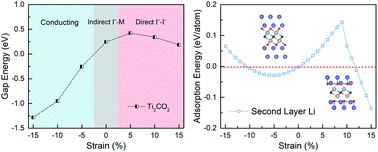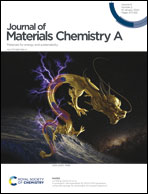Strain-tunable electronic properties and lithium storage of 2D transition metal carbide (MXene) Ti2CO2 as a flexible electrode†
Abstract
Two-dimensional MXenes have attracted considerable interest as promising flexible electrode candidates due to their favorable flexibility and high specific capacitance. Thus, taking Ti2CO2 as the representative MXene, we have investigated the strain effects on electronic properties with focus on lithium adsorption and structural transformation by using first-principles calculations. It is found that the indirect band gap in pristine Ti2CO2 changes to a direct band gap with tensile strain and closes with compressive strain. The adsorption of the first Li layer will attract the unoccupied nearly free electron (NFE) states in pristine Ti2CO2 down to the Fermi level in Ti2CO2Li2 while the adsorption of the second Li layer results in little change in the electronic structures owing to the pinning effects of NFE states near the Fermi level in Ti2CO2Li2. Moreover, the surface adsorption of Li atoms up to bilayers on Ti2CO2 is predicted to be energetically favorable and could be further stabilized by suppression. Meanwhile, the theoretical exploration predicts a possible decomposition of Ti2CO2Li4 back to Ti2C and Li2O under critical tensile strains. This work provides encouraging results for the strain-tunable conduction behavior and lithium storage in Ti2CO2 and further sheds light on the design and selection of electrode candidates for flexible energy storage applications.



 Please wait while we load your content...
Please wait while we load your content...